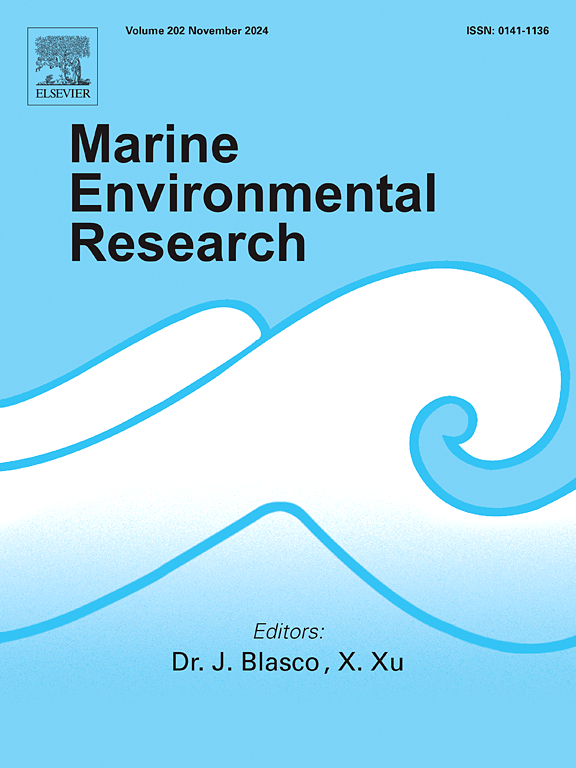Transcription of genes involved in bleaching of a coral reef species Acropora downingi (Wallace, 1999) in response to high temperature
IF 3
3区 环境科学与生态学
Q2 ENVIRONMENTAL SCIENCES
引用次数: 0
Abstract
Anthropogenic-induced global warming poses a significant threat to coral reef ecosystems worldwide. However, certain species within the Persian Gulf exhibit remarkable resilience to elevated temperatures compared to their counterparts in other reef systems. To understand the thermal tolerance in Persian Gulf corals and their molecular responses to extreme warm temperatures, Acropora downingi specimens collected from Larak Island were subjected to a heat shock of 34 ± 1 °C. We evaluated coral coloration, bleaching, and mRNA expression of biomarkers related to heat shock proteins (HSPs) such as Hsp70 and Hsp90, oxidative stress markers like Catalase and manganese superoxide dismutase (Cat and Mn-Sod), anti-apoptotic factors exemplified by B-cell lymphoma 2 (Bcl-2), and calcification-related genes including galaxin (Gal) after 24 h and 48 h of thermal shock exposure. Exposure of A. downingi to a 48-h heat shock at 34 °C resulted in noticeable fading of coral coloration compared to the control group. Despite this, the corals demonstrated resilience and did not undergo complete bleaching. Our findings also revealed significant increase of Hsp70, Hsp90, Cat, Mn-Sod, Bcl-2, and Gal mRNA expression after 24 h of thermal stress. However, after 48 h, transcripts for Hsp90, Cat, and Gal were observed to be decreased. These results suggest the pivotal roles played by genes involved in HSP signaling pathways, oxidative stress responses, anti-apoptosis processes, and calcification processes in the Persian Gulf coral's adaptation to thermal stress and its resistance to bleaching.
一种珊瑚礁物种Acropora downingi (Wallace, 1999)在高温下白化相关基因的转录
人为引起的全球变暖对全球珊瑚礁生态系统构成了重大威胁。然而,波斯湾的某些物种与其他珊瑚礁系统的同类相比,对高温表现出了非凡的适应能力。为了了解波斯湾珊瑚的耐热性及其对极端温暖温度的分子反应,在Larak岛采集的Acropora downingi标本进行了34±1°C的热冲击实验。我们评估了24小时和48小时热休克暴露后珊瑚的变色、漂白和与热休克蛋白(HSPs)相关的生物标志物(如Hsp70和Hsp90)、氧化应激标志物(如过氧化氢酶和锰超氧化物歧化酶(Cat和Mn-Sod))、抗凋亡因子(如b细胞淋巴瘤2 (Bcl-2))以及钙化相关基因(包括galaxin (Gal))的mRNA表达。与对照组相比,将a . downingi暴露在34°C的48小时热休克中导致珊瑚颜色明显褪色。尽管如此,珊瑚表现出弹性,并没有完全白化。热应激24 h后,Hsp70、Hsp90、Cat、Mn-Sod、Bcl-2和Gal mRNA的表达显著增加。然而,48小时后,Hsp90、Cat和Gal的转录本减少。这些结果表明,参与热休克蛋白信号通路、氧化应激反应、抗凋亡过程和钙化过程的基因在波斯湾珊瑚适应热应激和抵抗白化过程中发挥了关键作用。
本文章由计算机程序翻译,如有差异,请以英文原文为准。
求助全文
约1分钟内获得全文
求助全文
来源期刊

Marine environmental research
环境科学-毒理学
CiteScore
5.90
自引率
3.00%
发文量
217
审稿时长
46 days
期刊介绍:
Marine Environmental Research publishes original research papers on chemical, physical, and biological interactions in the oceans and coastal waters. The journal serves as a forum for new information on biology, chemistry, and toxicology and syntheses that advance understanding of marine environmental processes.
Submission of multidisciplinary studies is encouraged. Studies that utilize experimental approaches to clarify the roles of anthropogenic and natural causes of changes in marine ecosystems are especially welcome, as are those studies that represent new developments of a theoretical or conceptual aspect of marine science. All papers published in this journal are reviewed by qualified peers prior to acceptance and publication. Examples of topics considered to be appropriate for the journal include, but are not limited to, the following:
– The extent, persistence, and consequences of change and the recovery from such change in natural marine systems
– The biochemical, physiological, and ecological consequences of contaminants to marine organisms and ecosystems
– The biogeochemistry of naturally occurring and anthropogenic substances
– Models that describe and predict the above processes
– Monitoring studies, to the extent that their results provide new information on functional processes
– Methodological papers describing improved quantitative techniques for the marine sciences.
 求助内容:
求助内容: 应助结果提醒方式:
应助结果提醒方式:


